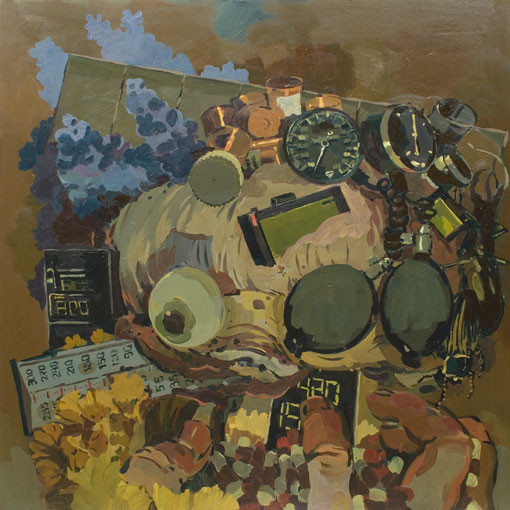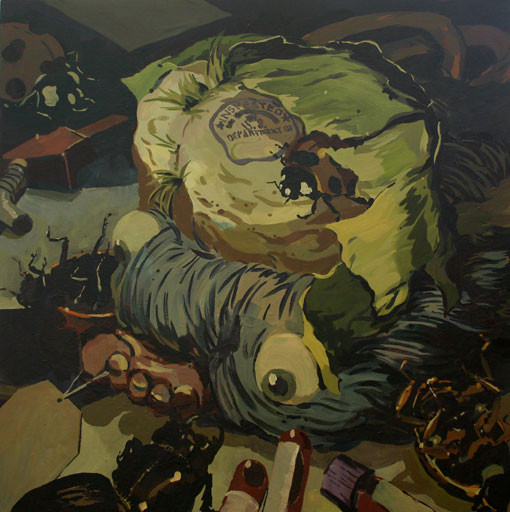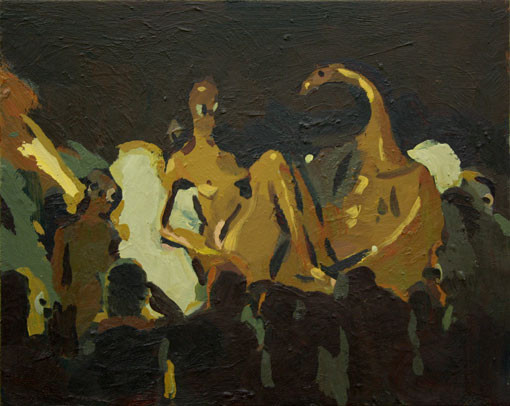Charles Karubian
30 Aug - 04 Oct 2008

Charles Karubian, Untitled, 2008, Oil on canvas, 152.4 x 152.4 cm / 60 x 60 inch
Courtesy Galerie Bob van Orsouw, Zurich
Courtesy Galerie Bob van Orsouw, Zurich

Charles Karubian
Untitled, 2008, Oil on canvas, 152.4 x 152.4 cm / 60 x 60 inch
Courtesy Galerie Bob van Orsouw, Zurich
Untitled, 2008, Oil on canvas, 152.4 x 152.4 cm / 60 x 60 inch
Courtesy Galerie Bob van Orsouw, Zurich

Charles Karubian
Untitled, 2008, Oil on canvas, 35.6 x 45.7 cm / 14 x 18 inch
Courtesy Galerie Bob van Orsouw, Zurich
Untitled, 2008, Oil on canvas, 35.6 x 45.7 cm / 14 x 18 inch
Courtesy Galerie Bob van Orsouw, Zurich
Within the framework of Suzie Q Projects, Birgid Uccia and Bob van Orsouw are happy to show, for the first time in Switzerland, a solo exhibition of paintings by Charles Karubian. Karubian was born 1969 in Los Angeles, where he lives and works today.
Karubian avows his allegiance to the tradition of western still-life and portrait painting, since the recourse to these genres makes his self-assurance as a painter possible. It is in this sense that he calls the production of still lifes and portraits “existential exercises”. Yet the fact remains that the way he handles the whole is “essentially ironic”, since he feels exempt from any conventional iconographic imperatives or symbolic systems.
In his oil paintings, subdued in nuances of dark color and of light, Karubian blurs the boundary between the classical genres. In his works we encounter the coexistence of the most diverse motifs, such as flowers, animals, human organs, technical instruments, empty cans, etc. Eyes and hands float freely across the picture plane; detached from the body, they are combined with riotously arranged fruits and outsized insects. The artist forswears accurate detail and is more interested in the fall of the light and the composition of the picture elements.
Impermanence is inherent in Karubian’s pictorial agenda, for he replaces costly tableware and the hourglass in the traditional still life with technical measuring instruments and digital displays. At the same time, however, for paintings that he executes in nonchalant style, he foregoes any kind of a clear arrangement of the objects. Instead, these tend to pile up on the picture plane like mountains of commodities without any inner coherence. At times their disparity has a touch of the uncanny. In just the same way he belies the integrality of the physiognomic expression as it is known from classical portrait painting. By repeatedly painting the human eye in isolation, Karubian reflects not only the relation between picture and viewer, but also ways of defining this tradition against the background of today’s habits of seeing and thinking. In the same way, the themes of war, sexuality and violence become semantic carriers; the artist declares them to be “culture-defining aspects” that impressively take on form within the classical picture genres that he deploys.
Birgid Uccia
Karubian avows his allegiance to the tradition of western still-life and portrait painting, since the recourse to these genres makes his self-assurance as a painter possible. It is in this sense that he calls the production of still lifes and portraits “existential exercises”. Yet the fact remains that the way he handles the whole is “essentially ironic”, since he feels exempt from any conventional iconographic imperatives or symbolic systems.
In his oil paintings, subdued in nuances of dark color and of light, Karubian blurs the boundary between the classical genres. In his works we encounter the coexistence of the most diverse motifs, such as flowers, animals, human organs, technical instruments, empty cans, etc. Eyes and hands float freely across the picture plane; detached from the body, they are combined with riotously arranged fruits and outsized insects. The artist forswears accurate detail and is more interested in the fall of the light and the composition of the picture elements.
Impermanence is inherent in Karubian’s pictorial agenda, for he replaces costly tableware and the hourglass in the traditional still life with technical measuring instruments and digital displays. At the same time, however, for paintings that he executes in nonchalant style, he foregoes any kind of a clear arrangement of the objects. Instead, these tend to pile up on the picture plane like mountains of commodities without any inner coherence. At times their disparity has a touch of the uncanny. In just the same way he belies the integrality of the physiognomic expression as it is known from classical portrait painting. By repeatedly painting the human eye in isolation, Karubian reflects not only the relation between picture and viewer, but also ways of defining this tradition against the background of today’s habits of seeing and thinking. In the same way, the themes of war, sexuality and violence become semantic carriers; the artist declares them to be “culture-defining aspects” that impressively take on form within the classical picture genres that he deploys.
Birgid Uccia

